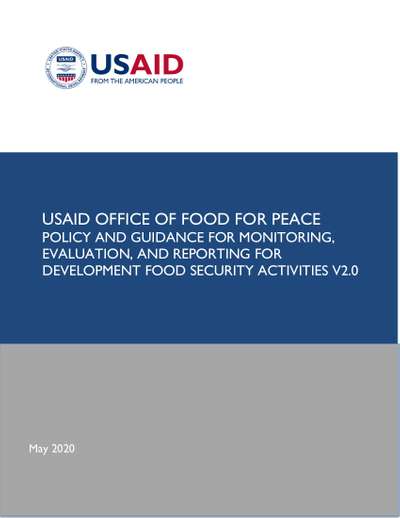USAID Pause and Reflect Toolkit USAID Office of Food for Peace Policy & Guidance for Monitoring, Evaluation, & Reporting for Development Food Security Activities V2.0

The U.S. Agency for International Development’s (USAID) Office of Food for Peace (FFP) funds development food security activities (DFSA) with an objective to improve and sustain the food and nutrition security of vulnerable populations. USAID applies the best available evidence to document activity effectiveness and improve program design and implementation.
FFP has an obligation to the federal government and the American people to ensure that resources are used efficiently to achieve the best possible food security outcomes and that, in the process, food assistance actors learn from experience how to improve activity design and implementation. This FFP Policy and Guidance for Monitoring, Evaluation, and Reporting for Development Food Security Activities describes key monitoring, evaluation, and reporting responsibilities of FFP development activity applicants and partners. This guidance has been updated to reflect FFP’s current multi-year food security activities and the newly adopted approach to DFSA design and implementation called “Refine and Implement” (R&I). This approach enables implementing partners and USAID to focus on formative research and/or analysis in the first phase to further refine the technical approach(es) that will be carried out in the second phase of the activity life cycle. Given that many FFP development activities are now using the R&I approach, this guidance is updated to include guidance for R&I activities.
Chapter 1 provides an overview of FFP M&E requirements and timelines for submission of the M&E Plan components. Chapter 2 outlines requirements for the Theory of Change (TOC), Logical Framework (LogFrame), Indicator Performance Tracking Table (IPTT), Performance Indicator Reference Sheets (PIRS), and Qualitative Inquiry Planning Sheets (QuIPS). Guidance on monitoring and M&E Staffing and Capacity Development Strategy is presented in Chapter 3, and guidance for evaluation plans is presented in Chapter 4.
Annex 1 provides an overview of the baseline study; this annex serves to inform partners about the objectives and methodology of the baseline. Annex II provides guidance on midterm evaluations; this annex is intended for activity implementing partners and research/evaluation partners who will be leading or participating in midterm evaluations. Annex III provides an overview of the interim/final evaluation; this annex serves to inform partners about the objectives and methodology of the interim/final evaluation. Annex IV provides technical guidance for partners on management information system (MIS) principles. Annex V is a template for Qualitative Inquiry Planning Sheets (QuIPS), which should be used by partners to outline performance monitoring and special studies using qualitative methods and tools. Applicants and partners are encouraged to use this and other templates included in this guidance document when developing their M&E Plans, but may use other formats if the required information is included.
All changes from the December 2016 guidance are highlighted in yellow. To improve readability, only the titles of new or substantially revised sections or subsections are highlighted. Additionally, while FFP now uses the term direct activity “participant” for development activities (rather than “beneficiary”) this change in terminology is not highlighted in the text that follows to improve readability.